Spectral Kurtosis Based Methodology for the Identification of Stationary Load Signatures in Electrical Signals from a Sustainable Building
Abstract
:1. Introduction
2. LUCIA Nearly Zero Energy Building
- (a)
- Solar photovoltaic energy: A part of the electric energy consumption is covered by two photovoltaic generation systems that are installed in the building. One of them is compounded by several photovoltaic modules that are located on the outer face of the double curtain wall in the central area of the southeast side of the building (Figure 2a). This first system (herein called the south system) delivers a rated power of 10 kW. The second system consists of photovoltaic glasses incorporated in two skylights (Figure 2b) above each one of the stairwells in the two communication blocks of the building; therefore, this system fulfills a double function: it provides natural lighting as a part of the roof structure, and it also produces energy delivering a rated power of about 5 kW.
- (b)
- Trigeneration system: There is a biomass cogeneration installation with a nominal power of 100 kWe and about 180 kWt. It is a gasifier that transforms biomass and wood chips, into syngas that feeds some internal combustion engines. The thermal use of the system, when there is a demand for cooling, is completed with the installation of an absorption chiller that allows the air conditioning installation to provide cold.
- (c)
- Installation of air conditioning and ventilation: it is a mixed air-water system with four-pipe fan coils as terminal units that allow to provide heating and cooling simultaneously in different parts of the building. The air is treated in the primary air conditioning system, equipped with a high-efficiency adiabatic heat recovery unit before it is delivered to the different locations inside the building through the fan coils.
- (d)
- Both, the motors of the pumps from the hydraulic circuits and the motors from the fans of the air conditioner, are connected to variable frequency drives (VFD) that allow achieving the maximum efficiency by adjusting the operating conditions to the instantaneous needs. This way, only the required water flow is handled.
- (e)
- Intelligent building management through a supervision, control and monitoring system of the facilities that allow configuring the different elements of the air conditioning and lighting systems for an efficient operation.
- For lighting control, there are light intensity sensors that regulate and adjust the luminosity of the lamps in the workspaces when they need to be turned on. In the common areas, there are also presence detectors to limit the lamp activation to the necessary moments and when the levels of natural lighting are not sufficient.
- For air conditioning, there are thermostats in each space that allow to independently regulate and control the contribution of heath or cold in each room.
- The building is fully monitored in terms of thermal and electrical parameters; it counts with 97 grid analyzers that allow knowing the consumption of each workspace in the facility as well as the energy that is being produced by generation systems located in the building. It also integrates seven thermal energy meters at different locations within the air conditioning installation; temperature sensors in offices, laboratories and common spaces and even a weather station on the roof of the building to know different environmental and meteorological parameters.
3. Methodology
- A spectral analysis, which is in charge of the identification and quantification of stationary frequency components (SFC) in electrical signals and will, in turn, be performed in three stages. First, the SK is used for the detection of SFC in current signals in order to identify specific frequency components that are related to consumption habits in the building. Then, since there are frequency components that are irrelevant to the study, discrimination of non-significant SFC is performed based on characteristics, such as amplitude variability throughout the day, and persistence during working hours. Finally, FFT is performed on the current signal to quantify the SFC detected by the SK.
- A PQ analysis, which aims to assess the impact of SFCs on the smart building network. A PQ analysis is performed with the current and voltage signals to calculate the power consumption and THD associated with the loads inside the building.
3.1. Spectral Analysis
3.1.1. Detection of the SFC
3.1.2. Discrimination of the Non-Significant SFC
3.1.3. Quantification of the SFC
3.2. Power Quality Analysis
4. Experimental Setup
4.1. Description of the Data Acquisition System
4.2. Description of the Experimentation Dates
5. Results and Discussion
5.1. Stationary Frequency Components and Loads Estimation
5.2. PQ Analysis
6. Conclusions
Author Contributions
Funding
Institutional Review Board Statement
Informed Consent Statement
Conflicts of Interest
References
- Al Dakheel, J.; Del Pero, C.; Aste, N.; Leonforte, F. Smart buildings features and key performance indicators: A review. Sustain. Cities Soc. 2020, 61, 102328. [Google Scholar] [CrossRef]
- Golpîra, H.; Khan, S.A.R. A multi-objective risk-based robust optimization approach to energy management in smart residential buildings under combined demand and supply uncertainty. Energy 2019, 170, 1113–1129. [Google Scholar] [CrossRef]
- Marinakis, V.; Karakosta, C.; Doukas, H.; Androulaki, S.; Psarras, J. A building automation and control tool for remote and real time monitoring of energy consumption. Sustain. Cities Soc. 2013, 6, 11–15. [Google Scholar] [CrossRef]
- Ciugudeanu, C.; Buzdugan, M.; Beu, D.; Campianu, A.; Galatanu, C.D. Sustainable Lighting-Retrofit Versus Dedicated Luminaires-Light Versus Power Quality. Sustainability 2019, 11, 7125. [Google Scholar] [CrossRef] [Green Version]
- Lucia, O.; Cvetkovic, I.; Sarnago, H.; Boroyevich, D.; Mattavelli, P.; Lee, F.C. Design of Home Appliances for a DC-Based Nanogrid System: An Induction Range Study Case. IEEE J. Emerg. Sel. Top. Power Electron. 2013, 1, 315–326. [Google Scholar] [CrossRef]
- Pena-Alzola, R.; Bianchi, M.A.; Ordonez, M. Control Design of a PFC with Harmonic Mitigation Function for Small Hybrid AC/DC Buildings. IEEE Trans. Power Electron. 2015, 31, 6607–6620. [Google Scholar] [CrossRef]
- Nallusamy, S.; Velayutham, D.; Govindarajan, U.; Parvathyshankar, D. Power quality improvement in a low-voltage DC ceiling grid powered system. IET Power Electron. 2015, 8, 1902–1911. [Google Scholar] [CrossRef]
- Wunder, B.; Ott, L.; Szpek, M.; Boeke, U.; Weiß, R. Energy efficient DC-grids for commercial buildings. In Proceedings of the 2014 IEEE 36th International Telecommunications Energy Conference (IN TEL EC), Sao Paulo, Brazil, 17–20 August 2014; pp. 1–8. [Google Scholar]
- Parchure, A.; Tyler, S.J.; Peskin, M.A.; Rahimi, K.; Broadwater, R.P.; Dilek, M. Investigating PV Generation Induced Voltage Volatility for Customers Sharing a Distribution Service Transformer. IEEE Trans. Ind. Appl. 2017, 53, 71–79. [Google Scholar] [CrossRef]
- Alam, M.J.E.; Muttaqi, K.M.; Sutanto, D. Battery Energy Storage to Mitigate Rapid Voltage/Power Fluctuations in Power Grids Due to Fast Variations of Solar/Wind Outputs. IEEE Access 2021, 9, 12191–12202. [Google Scholar] [CrossRef]
- Chamana, M.; Chowdhury, B.H.; Jahanbakhsh, F. Distributed Control of Voltage Regulating Devices in the Presence of High PV Penetration to Mitigate Ramp-Rate Issues. IEEE Trans. Smart Grid 2018, 9, 1086–1095. [Google Scholar] [CrossRef]
- Elvira-Ortiz, D.A.; Morinigo-Sotelo, D.; Duque-Perez, O.; Jaen-Cuellar, A.Y.; Osornio-Rios, R.A.; Romero-Troncoso, R.D.J. Methodology for Flicker Estimation and Its Correlation to Environmental Factors in Photovoltaic Generation. IEEE Access 2018, 6, 24035–24047. [Google Scholar] [CrossRef]
- Zahedmanesh, A.; Muttaqi, K.M.; Sutanto, D. Alleviation of Voltage Variations Introduced by Unbalanced Allocation of Single-phase Loads in a Distribution Network Integrated with PVs and PEVs. In Proceedings of the 2020 IEEE International Conference on Power Electronics, Smart Grid and Renewable Energy (PESGRE2020), Kerala, India, 2–4 January 2020; pp. 1–6. [Google Scholar] [CrossRef]
- Raj, N.T.; Iniyan, S.; Goic, R. A review of renewable energy based cogeneration technologies. Renew. Sustain. Energy Rev. 2011, 15, 3640–3648. [Google Scholar] [CrossRef]
- Mancasi, M.; Vatu, R.; Ceaki, O.; Porumb, R.; Seritan, G. Evolution of smart buildings. A Romanian case. In Proceedings of the 2015 50th International Universities Power Engineering Conference (UPEC), Stoke-on-Trent, UK, 1–4 September 2015; pp. 1–4. [Google Scholar]
- Mahela, O.P.; Shaik, A.G.; Gupta, N. A critical review of detection and classification of power quality events. Renew. Sustain. Energy Rev. 2015, 41, 495–505. [Google Scholar] [CrossRef]
- Deng, H.; Gao, Y.; Chen, X.; Zhang, Y.; Wu, Q.; Zhao, H. Harmonic Analysis of Power Grid Based on FFT Algorithm. In Proceedings of the 2020 IEEE International Conference on Smart Cloud, Washington, DC, USA, 6–8 November 2020; pp. 161–164. [Google Scholar]
- Gupta, N.; Seethalekshmi, K.; Datta, S.S. Wavelet based real-time monitoring of electrical signals in Distributed Generation (DG) integrated system. Eng. Sci. Technol. Int. J. 2020, 24, 218–228. [Google Scholar] [CrossRef]
- Thirumala, K.; Pal, S.; Jain, T.; Umarikar, A.C. A classification method for multiple power quality disturbances using EWT based adaptive filtering and multiclass SVM. Neurocomputing 2019, 334, 265–274. [Google Scholar] [CrossRef]
- Rodriguez-Guerrero, M.A.; Carranza-Lopez-Padilla, R.; Osornio-Rios, R.A.; Romero-Troncoso, R.D.J. A novel methodology for modeling waveforms for power quality disturbance analysis. Electr. Power Syst. Res. 2017, 143, 14–24. [Google Scholar] [CrossRef]
- Elkholy, A. Harmonics assessment and mathematical modeling of power quality parameters for low voltage grid connected photovoltaic systems. Sol. Energy 2019, 183, 315–326. [Google Scholar] [CrossRef]
- Mishra, M. Power quality disturbance detection and classification using signal processing and soft computing techniques: A comprehensive review. Int. Trans. Electr. Energy Syst. 2019, 29. [Google Scholar] [CrossRef] [Green Version]
- Liu, Z.; Zhang, Q.; Han, Z.; Chen, G. A new classification method for transient power quality combining spectral kurtosis with neural network. Neurocomputing 2014, 125, 95–101. [Google Scholar] [CrossRef]
- Ray, P.K.; Eddy, Y.F.; Krishnan, A.; Dubey, H.C.; Gooi, H.B.; Amaratunga, G.A.J. Wavelet Trans-form-Spectral Kurtosis Based Hybrid Technique for Disturbance Detection in a Microgrid. In Proceedings of the 2018 IEEE Power & Energy Society General Meeting (PESGM), Portland, OR, USA, 5–10 August 2018; pp. 1–5. [Google Scholar]
- Sierra-Fernández, J.-M.; Rönnberg, S.; De La Rosa, J.-J.G.; Bollen, M.H.J.; Palomares-Salas, J.-C. Application of Spectral Kurtosis to Characterize Amplitude Variability in Power Systems’ Harmonics. Energies 2019, 12, 194. [Google Scholar] [CrossRef] [Green Version]
- Cifredo-Chacón, M.Á.; Perez-Peña, F.; Quirós-Olozábal, Á.; González-de-la-Rosa, J.J. Implementation of pro-cessing functions for autonomous power quality measurement equipment: A performance evaluation of CPU and FPGA-based embedded system. Energies 2019, 12, 914. [Google Scholar]
- Cai, G.; Wang, L.; Yang, D.; Sun, Z.; Wang, B. Harmonic Detection for Power Grids Using Adaptive Variational Mode Decomposition. Energies 2019, 12, 232. [Google Scholar] [CrossRef] [Green Version]
- Edificio LUCIA-Universidad de Valladolid. Available online: http://edificio-lucia.blogspot.com/ (accessed on 16 October 2021).
- LEED Rating System. Available online: https://www.usgbc.org/leed (accessed on 27 December 2021).
- Green Building Council España-Certificación Verde. Available online: https://gbce.es/certificacion-verde/ (accessed on 16 October 2021).
- Antoni, J. The spectral kurtosis: A useful tool for characterizing nonstationary signals. Mech. Syst. Signal Process. 2006, 20, 282–307. [Google Scholar]
- Enayati, J.; Moravej, Z. Real-time harmonics estimation in power systems using a novel hybrid algorithm. IET Gener. Transm. Distrib. 2017, 11, 3532–3538. [Google Scholar] [CrossRef]
- Nath, S.; Sinha, P.; Goswami, S.K. A wavelet based novel method for the detection of harmonic sources in power systems. Int. J. Electr. Power Energy Syst. 2012, 40, 54–61. [Google Scholar] [CrossRef]
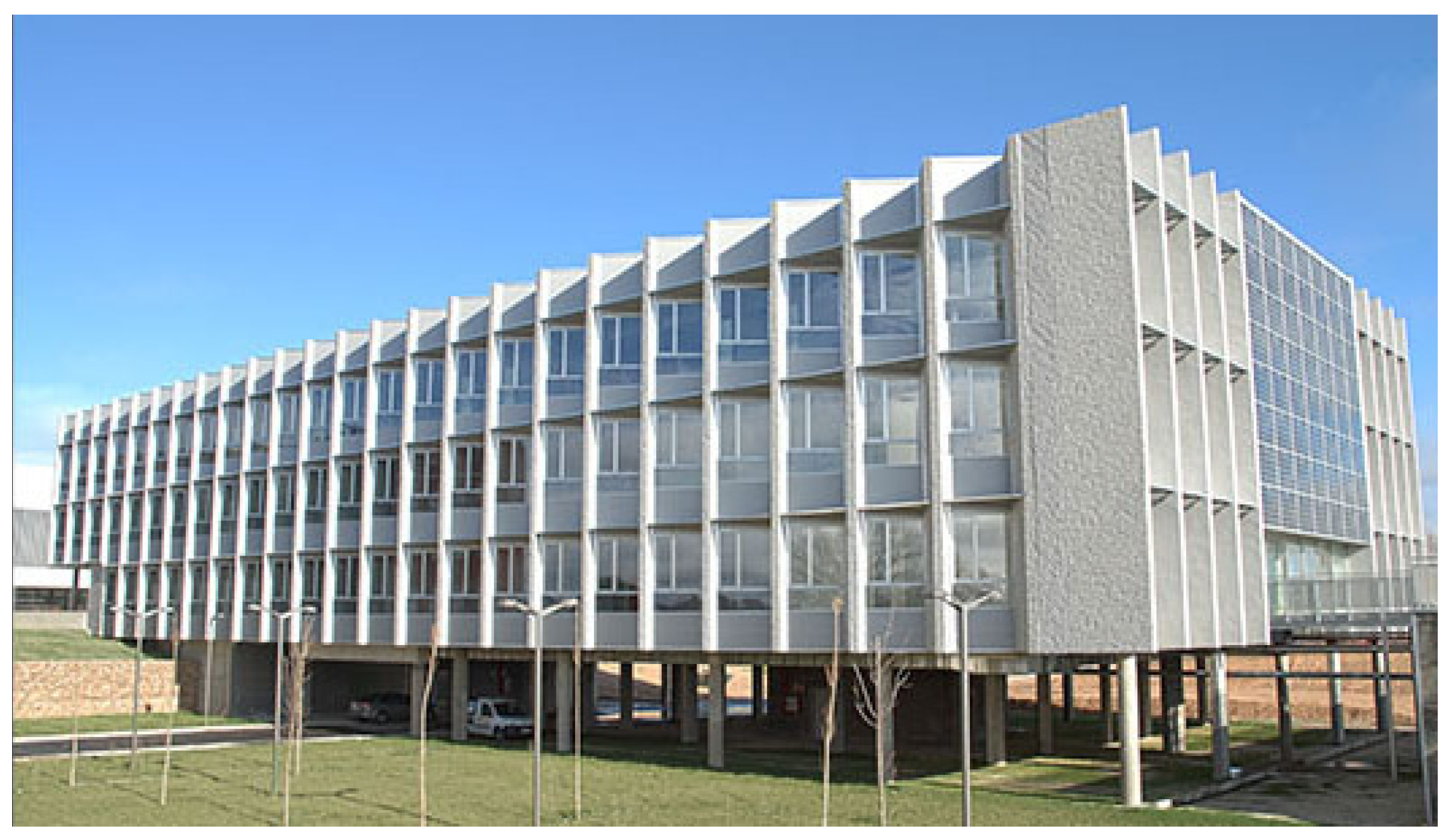

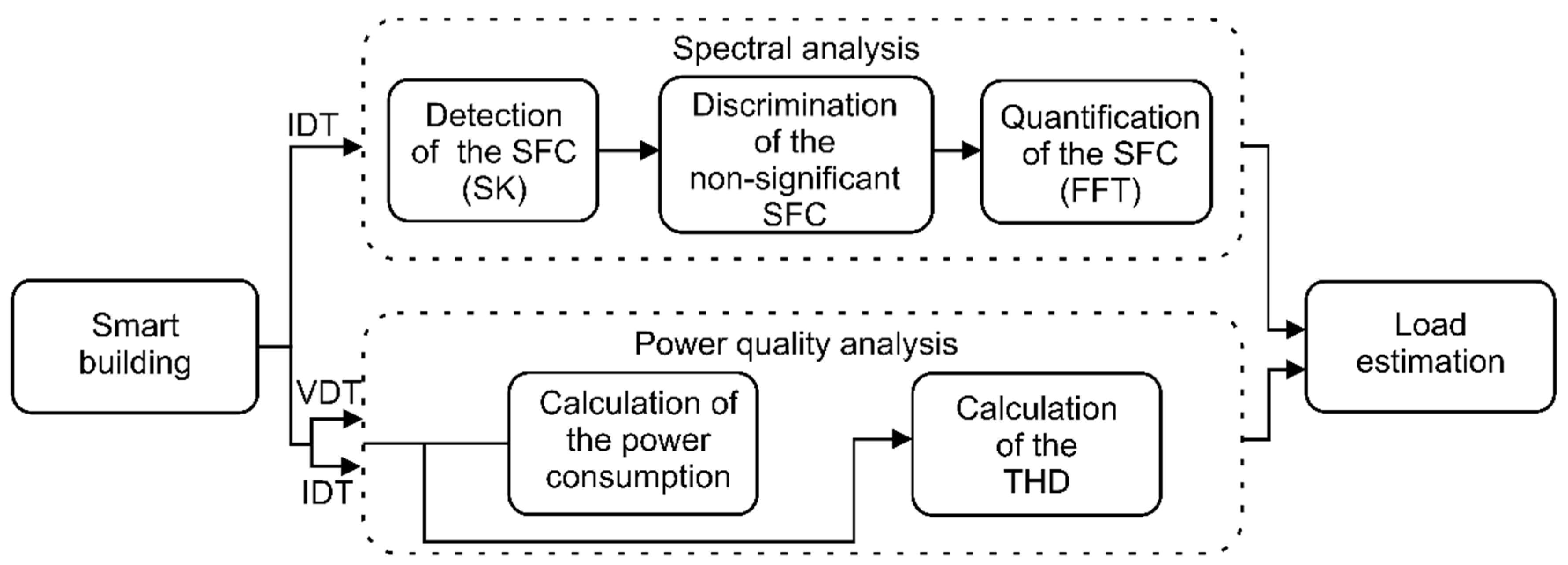
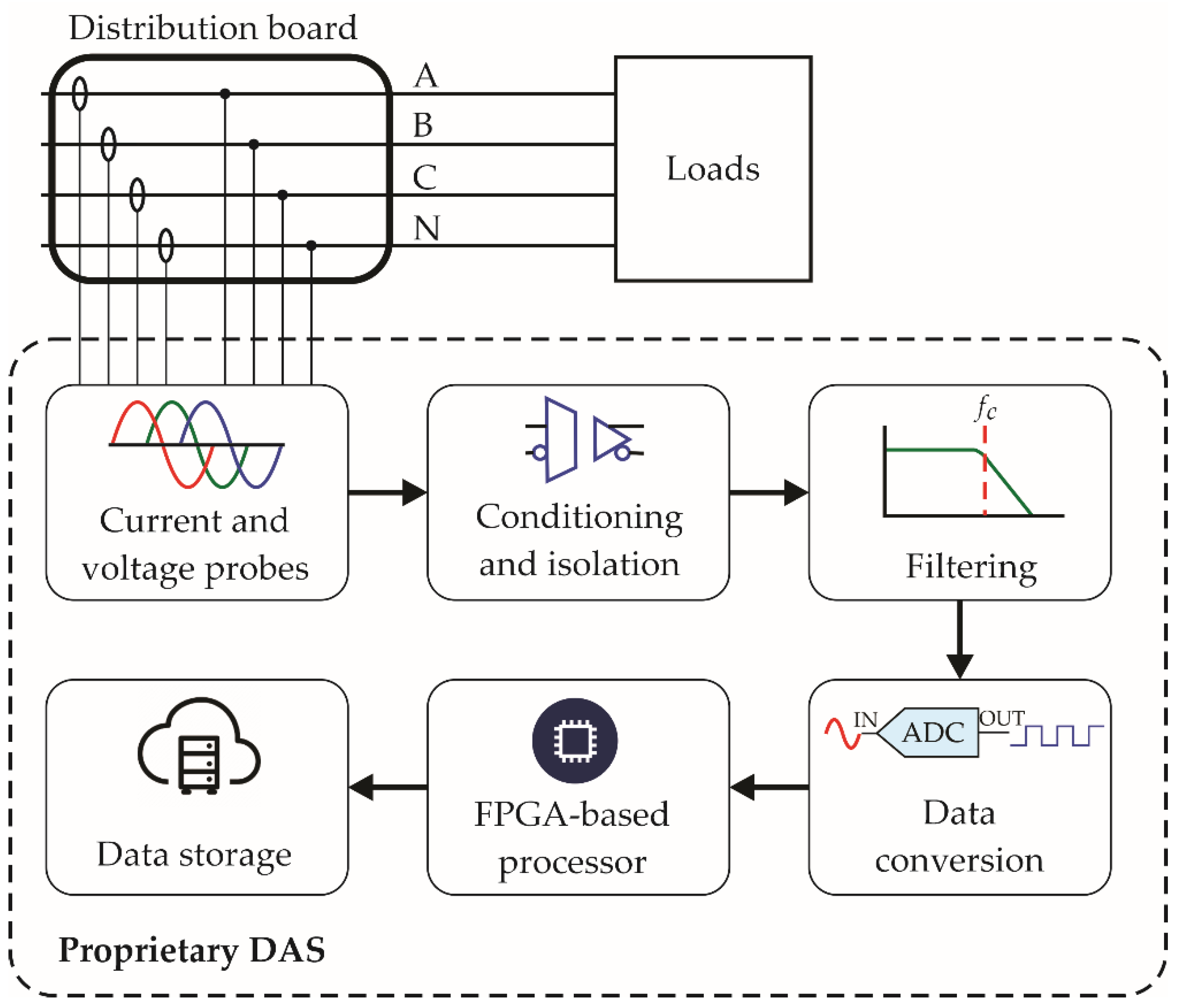


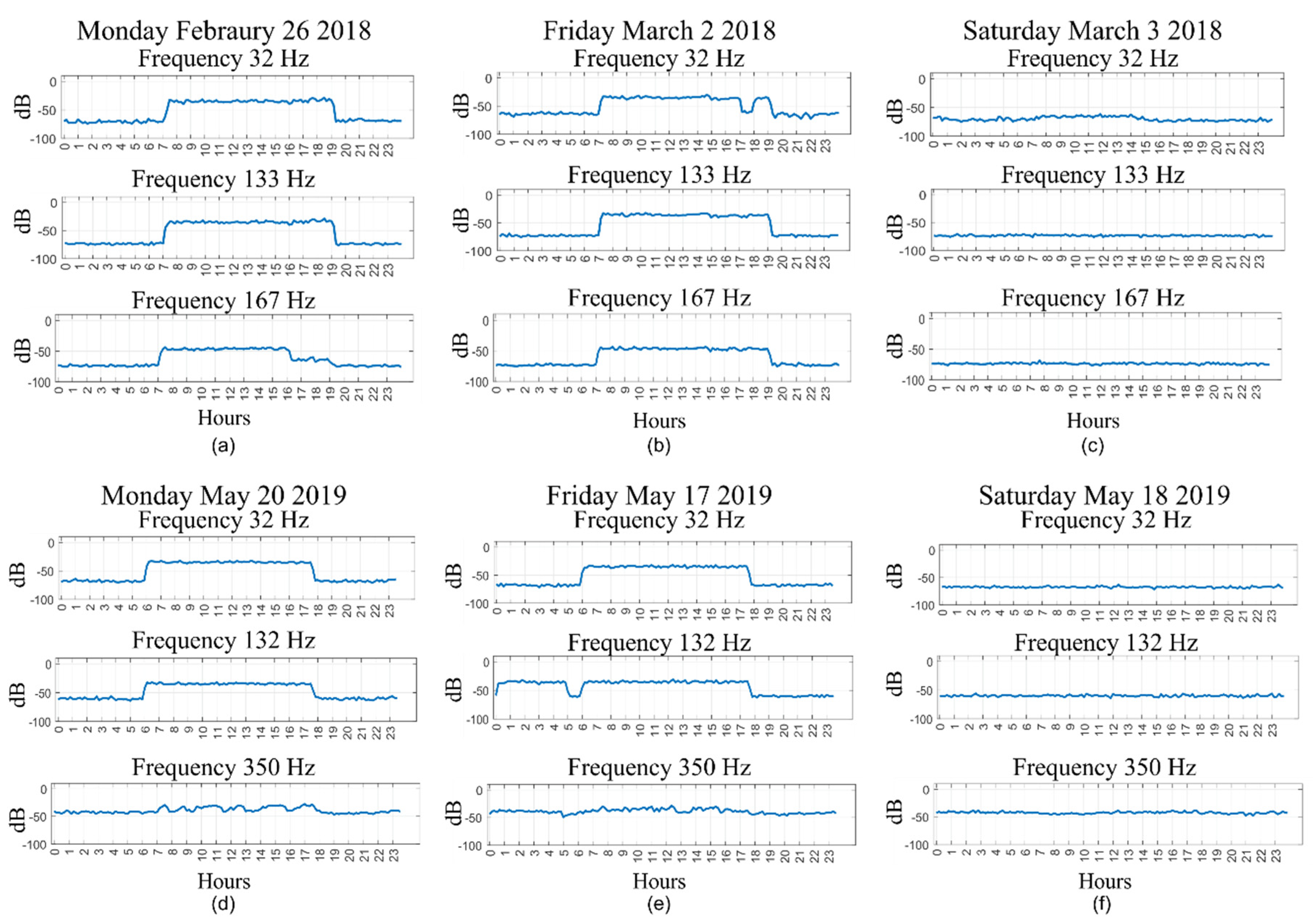
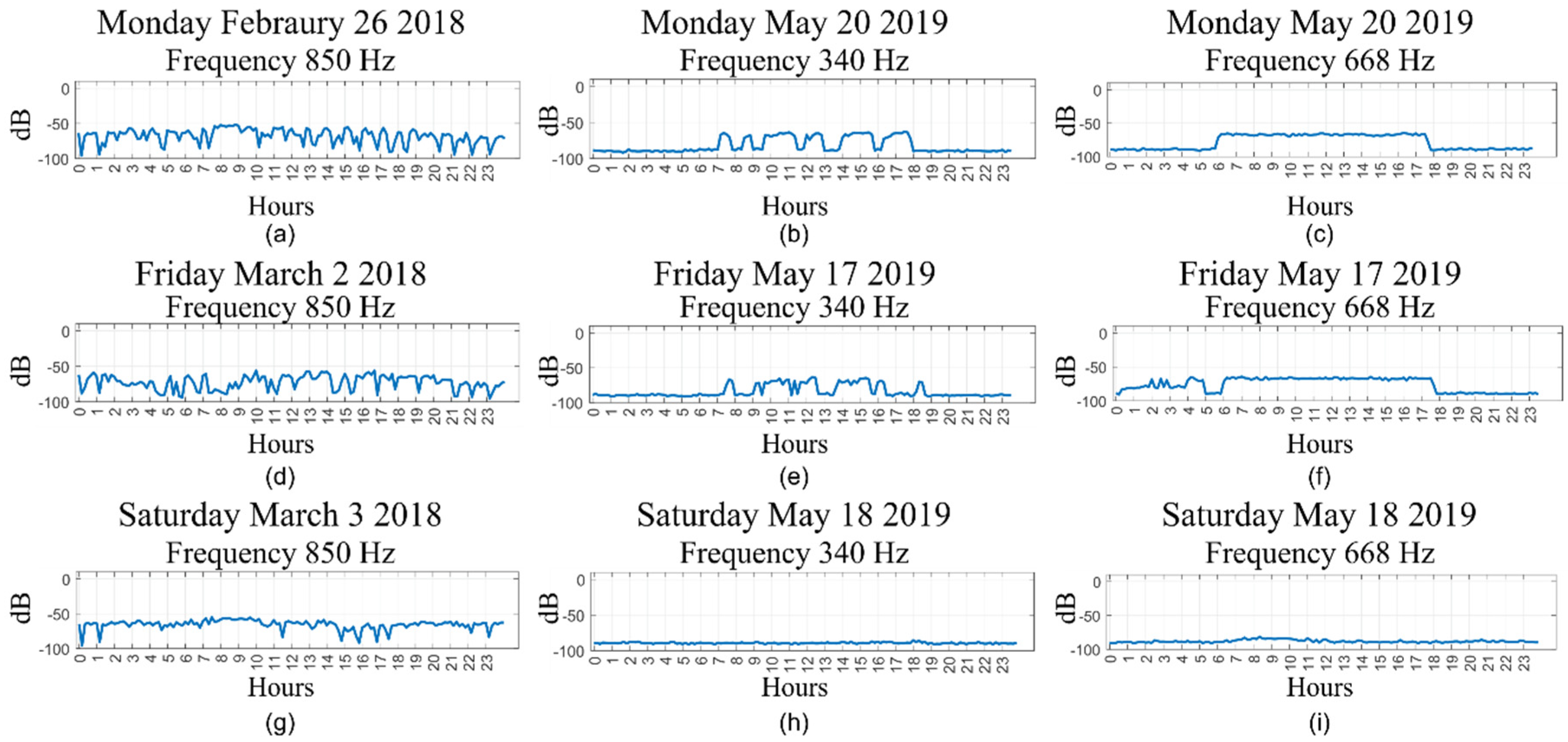
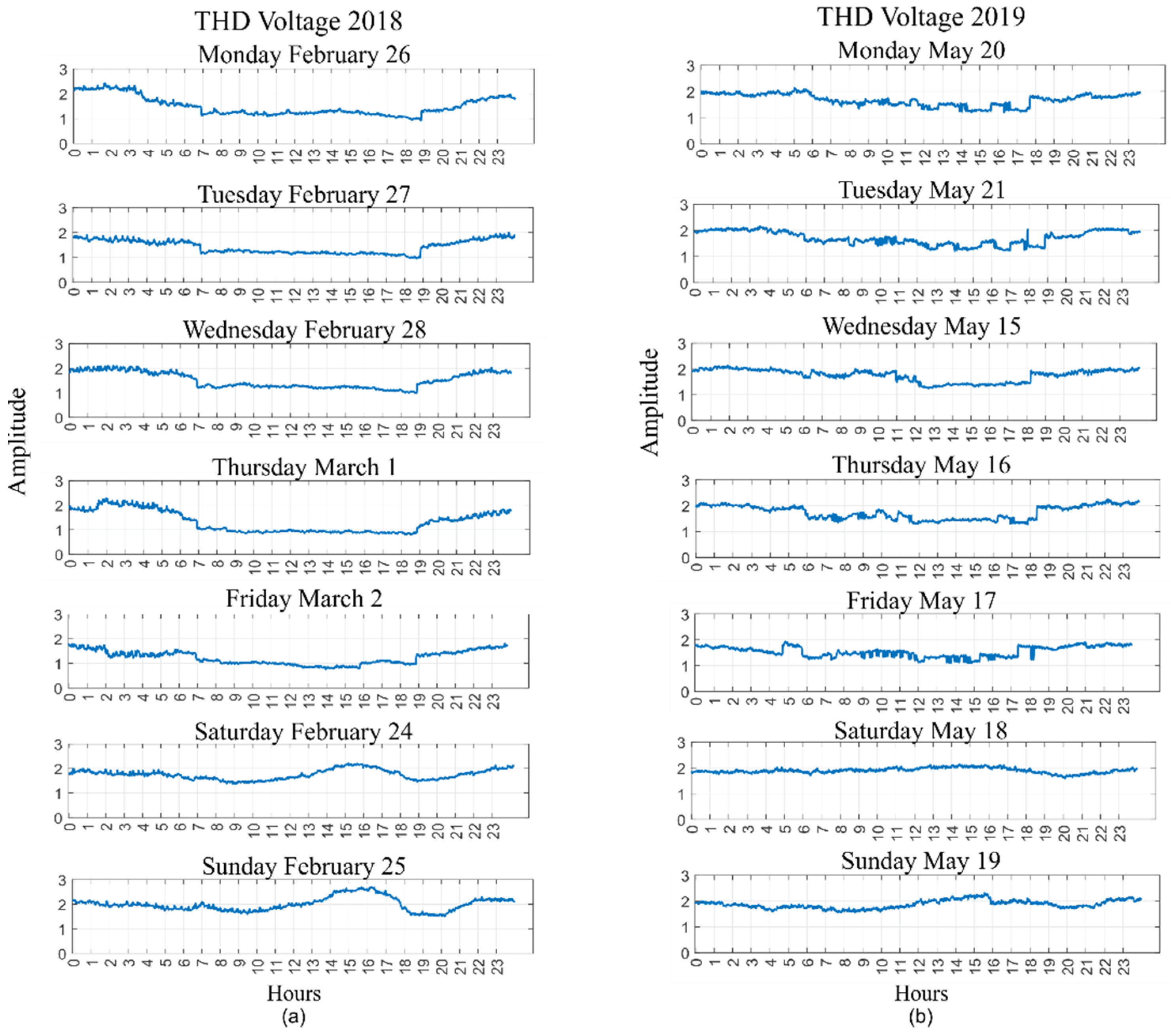
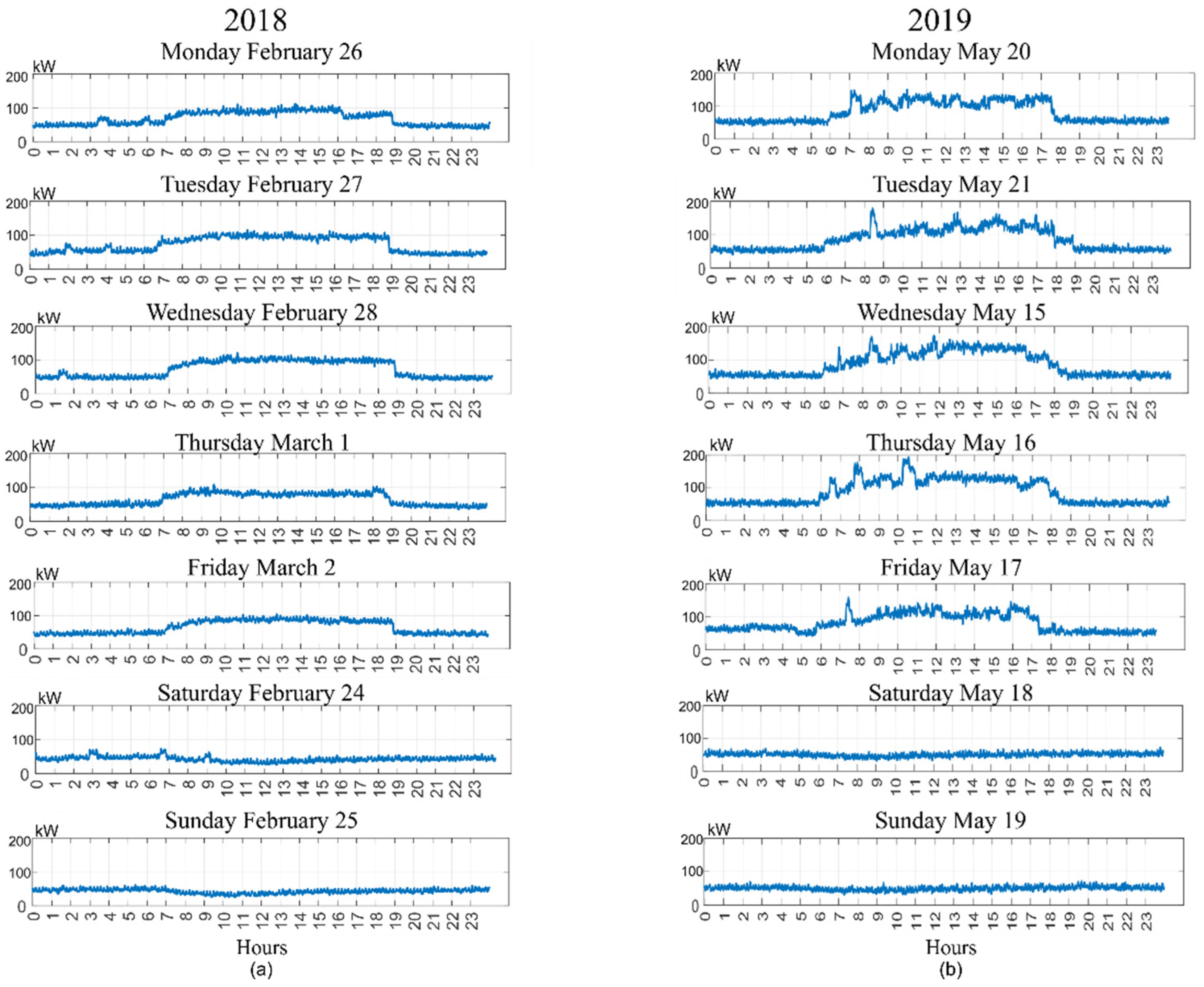
| Specification | Value |
|---|---|
| Voltage ratio | 13.2–20 kV/0.42 kV |
| Secondary voltage | 420 V |
| Short Circuit Voltage | 6% |
| Methodology | Identification of Stationary Harmonics | Identification of Stationary Interharmonics | Tracking Behavior over Time | Relationship with Possible Loads |
|---|---|---|---|---|
| SK [25] | x | - | 1 h | - |
| AVMD + HT [27] | x | - | - | - |
| RLS-IEKF [32] | x | x | - | - |
| WT [33] | x | - | - | x |
| SK-FFT (this work) | x | x | Weekly | x |
Publisher’s Note: MDPI stays neutral with regard to jurisdictional claims in published maps and institutional affiliations. |
© 2022 by the authors. Licensee MDPI, Basel, Switzerland. This article is an open access article distributed under the terms and conditions of the Creative Commons Attribution (CC BY) license (https://creativecommons.org/licenses/by/4.0/).
Share and Cite
Romero-Ramirez, L.A.; Elvira-Ortiz, D.A.; Romero-Troncoso, R.d.J.; Osornio-Rios, R.A.; Zorita-Lamadrid, A.L.; Gonzalez-Gonzalez, S.L.; Morinigo-Sotelo, D. Spectral Kurtosis Based Methodology for the Identification of Stationary Load Signatures in Electrical Signals from a Sustainable Building. Energies 2022, 15, 2373. https://doi.org/10.3390/en15072373
Romero-Ramirez LA, Elvira-Ortiz DA, Romero-Troncoso RdJ, Osornio-Rios RA, Zorita-Lamadrid AL, Gonzalez-Gonzalez SL, Morinigo-Sotelo D. Spectral Kurtosis Based Methodology for the Identification of Stationary Load Signatures in Electrical Signals from a Sustainable Building. Energies. 2022; 15(7):2373. https://doi.org/10.3390/en15072373
Chicago/Turabian StyleRomero-Ramirez, Luis A., David A. Elvira-Ortiz, Rene de J. Romero-Troncoso, Roque A. Osornio-Rios, Angel L. Zorita-Lamadrid, Sergio L. Gonzalez-Gonzalez, and Daniel Morinigo-Sotelo. 2022. "Spectral Kurtosis Based Methodology for the Identification of Stationary Load Signatures in Electrical Signals from a Sustainable Building" Energies 15, no. 7: 2373. https://doi.org/10.3390/en15072373







